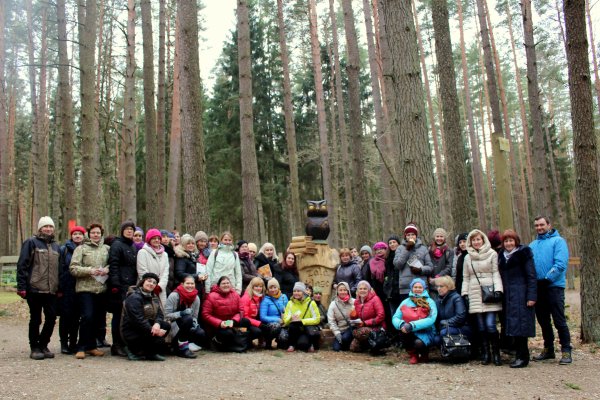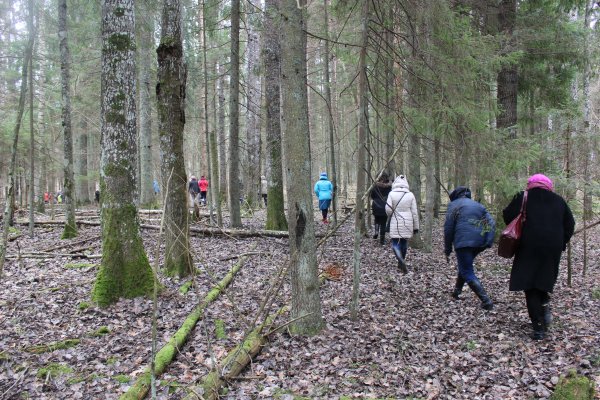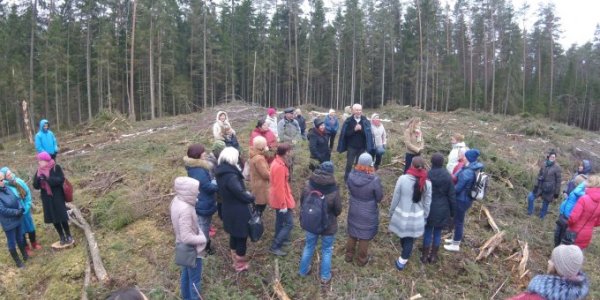Teachers explore the forest
While school students are off on their spring holidays, 50 teachers spend their time learning about processes taking place in the forest, and about responsible forest management, ensured by JSC "Latvia's State Forests" (LVM) in recreation eco-forest in Īle. The teachers also searched inspiration for their own classes in LVM Nature Park in Tērvete.
15 March began early with a trip to Zemgale to visit Īle partisan bunker. Here Gundars Freimanis, Manager of Īle Forest District, told the teachers about the important historical events that took place in this area, as well as about the history of the bunker itself. "Modris Zihmanis is the only partisan of Īle bunker, who is still alive today; thanks to his stories and memories, we have clarified a number of facts, and restored the bunker. But, of course, there are still questions that have not been answered," says Gundars Freimanis, who participated in the restoration of the bunker in 2014.
In turn, Kaspars Riže, LVM Senior Forest Expert, introduced teachers to the history of JSC "Latvia's State Forests" (LVM), its structural units, social responsibility and goals of the company. Kaspars Riže addressed the teachers as "colleagues", highly appreciating their daily work with the students. Kaspars himself is actively involved in the international education programme "Learning about Forests", where he uses practical examples and tasks to tell the youth about processes taking place in the forest, and to teach them about the forest management cycle.
This time, the expert invited teachers to share their knowledge in determining the age of young stands, explaining the role of ecological tree groups in a seamless renewal felling (clear felling), and to respond to other tricky questions, revealing the basic principles of responsible forest management. The expert addressed the concerns expressed by some of the teachers, namely, that it will take a long time till forest's bounty will again start growing in a clear felling. A clearing, in fact, is a much more suitable environment for wild strawberries and raspberries, while in the young stands one will often find red bilberries and blueberries. Berry-pickers should not pick berries along highways and other intensively used roads, because berries tend to accumulate pollution caused by cars.
Teachers learned about the importance of taking proper care of removals and of sanitary felling, and went for a walk in Īle forest; this is a place where trees of felling age are growing, and some time ago selective felling was carried out here. "In selective felling, part of the mature stand is removed, thus promoting reforestation; unfortunately the majority of tree species growing in Latvia are sun-loving trees, with the exception of the spruce, which is able to grow also in shade," says the LVM expert. Upon carrying out seamless renewal felling and preserving the structures characteristic to a natural forest, a large-scale natural disturbance - a forest fire - is imitated, and the subsequent soil preparation contributes to the soil surface mineralisation. In turn, upon carrying out selective and gradual felling, low-intensity natural disturbances - such as windfall, falling of individual trees, diseases and pest damage - are imitated.
"Time spent in the forest together with such knowledgeable experts allows us to gain new knowledge and to raise awareness of the different aspects of forest management. The heart is always longing for the forest, but the work and duties limit the possibilities and time that can be spent in the forest. A forest that is difficult to access, where no thinning has been carried out, is not a nice place for walks; besides, for trees it is also very difficult to grow there," says the teacher, who highly appreciates the opportunity to see the forest with her own eyes from a different perspective, and to gain understanding about the importance of management of recreation eco-forest in Īle.
Having learnt about historical events and responsible forest management, teachers went to draw inspiration for their own classes in LVM Nature Park in Tērvete. Crossing the new wooden pedestrian bridge – the laboratory - over the highway in Tērvete for the very first time, teachers took the chance to make a wish. Jānis Udrass, representative of LVM Nature Park in Tērvete, and Uldis Spulle, Deputy Director for Scientific Work at Forest and Wood Products Research and Development Institute MeKA, told the participants about the history of the bridge and its functionality in everyday life. The bridge has just received the third prize in the competition "Annual Awards of Latvian Construction Industry 2015" in the category "Wooden Construction". The representative of MeKA also introduced teachers to a number of innovative uses of wood in construction of both - bridges and high-rise buildings.
Thanks to the exciting stories told by LVM environmental guides, LVM Nature Park in Tērvete is not only a beloved leisure spot for families with children, but also a great place to gain new knowledge. The "Green Classroom" is like an open-air class where subjects can be taught in a new and interesting way, while educational environmental trails will reveal exciting opportunities how to learn about wood and forestry in nature. Here teachers were inspired to teach mathematics, science, physics and other subjects in a brand new way. The participants could test their knowledge in volumetric calculation, in recognition of nest boxes and tree buds.
"One weekend is no longer enough to explore the whole Nature Park in Tērvete. There are so many new and exciting things around us! All I have to do is settle the transportation issues, take my students along, and head to the "Green Classroom". Knowledge and inspiration of the environmental guides encouraging the teachers to colour and freshen up their classes, are very valuable," says a teacher from Kurzeme region, attending the LVM courses for teachers for the first time. This year she is eager to also get involved in the Mother Nature (Mammadaba) master class activities.
Upon leaving, each teacher received a small wooden block as an inspiration to be shared with their students and as a cornerstone for their future house of knowledge, to be built hand-in-hand with the students.



































